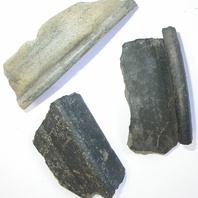
Viking Objects
Early Medieval Pottery Fragments (2001-59)
These are fragments of a Torksey ware rim, decorated Stamford ware rim, and a Stamford ware pot rim. Torksey ware was a type of pottery found in central England and dating to the period ad 850 to 1150. It was manufactured, initially by immigrant potters from Continental Europe, using a fast wheel at workshops around Torksey, Lincolnshire. While not having the same wide geographic distribution as Stamford ware, the popularity of Torksey ware in York was so high that it was initially thought that York was the original location of manufacture. Stamford ware is one of the earliest forms of lead-glazed ceramics in England, being produced in Stamford, Lincolnshire, between the ninth and thirteenth centuries and widely traded across Britain and the near continent. Early Stamford glazes were lead glazes, suggested by some to be unique among early English glazes since they contain traces of silver but not tin. The glaze could be of a pale yellow, orange, pale green, or smoke blue colour and was applied by using a brush.
Read More
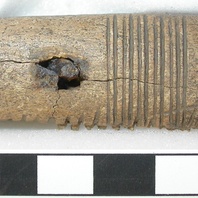
Viking Objects
Antler Comb (1986-976)
Fragments of an antler comb found on the site of Little Chester Roman fort (Derventio Coritanorum) in Derby. This comb is of Anglo-Scandinavian type. It consists of a flat plate of antler sandwiched between two strips of antler that are rounded on the exterior part. The whole is fixed together with an iron rivet. Nicks on the centre plate show that the teeth of the comb were cut after the three plates had been constructed and fixed.
Read More
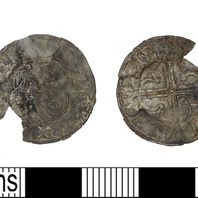
Viking Objects
Coin of Cnut the Great (LEIC-B1F8EA)
This coin is an example of a Quatrefoil type silver penny of Cnut, minted in Stamford or Norwich by the moneyer Thurstan. Minting coins was a way of controlling the means of exchange within a kingdom and one which created a more easily administered standardized system of trade. Moreover, the coins themselves were often used as propaganda, portraying symbols and statements that gave off a desired message. The Vikings later used the minting of coins to legitimise their own rule.
Read More
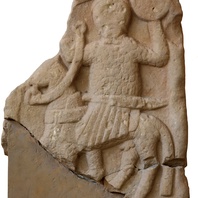
Viking Objects
Repton Stone (1989-59/1165)
The Repton Stone, as it is now known, was found in a pit near the eastern window of the Church of St Wystan, Repton, Derbyshire in 1979. It was originally carved on all four faces, but recognisable detail remains only on two of them. The Repton Stone is a section of a sandstone cross shaft carved on one side with a mounted armed figure (Face A), on the other with a monstrous creature eating the heads of two people (Face B). It was broken Face A: A moustachioed armed figure on horseback with sword and shield raised in the air is carved on this face. The horse is very clearly a stallion. Incised decoration, where the design is scratched into the surface, shows that the rider was depicted wearing armour and carrying a second weapon at his waist, perhaps a seax (knife or dagger). The armour was probably intended to be mail although the carving suggests scale. The mounted man appears to be wearing a diadem, suggesting that he was of high rank. He is wearing a pleated tunic under his armour, and has cross-gartered legs. The reins of the horse are looped over his right arm. Elements of the tack are clearly visible. Face B: This face would have been on the side of the cross. The monstrous creature on this face consists of a snake-like body with the face of a human being. The serpent beast appears to be devouring the heads of the two human figures that embrace in front of it. The serpent may be a representation of the Hellmouth devouring souls. The pit the stone was found in probably dates to the eleventh century or early twelfth century. However, the cross was probably much earlier in date, being broken up close to the time it was deposited in the pit. It is probable that the cross was made before the Viking camp in 873/4 because the monastery that stood on this site before the Vikings was not refounded after the Vikings adopted Christianity. The presence of this cross at the site of a Viking camp shows that Repton was an important place before the Vikings made it their temporary abode. This may have been one reason that the Vikings chose Repton for one of their camps, although its proximity to the River Trent would also have been an important factor. The Vikings used waterways to access the interior of the country, so it is not surprising to find their winter camps beside navigable rivers.
Read More
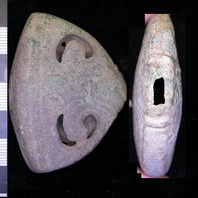
Viking Objects
Sword Pommel (LEIC-9158C3)
The pommel is probably a late development of Petersen’s type X which encompases transitional to medieval forms. Copper-alloy pommels with this basic shape are rare but not unknown in Viking Age Europe with a reasonably close example from Lough Derg, County Tipperary, in the National Museum of Ireland. The symmetrical Ringerike-style engraving is very similar to decoration commonly found on stirrup-strap mounts of the eleventh century.
Read More
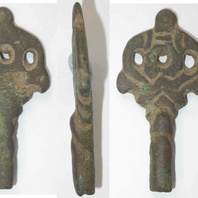
Viking Objects
Decorated Key (DENO-4259B3)
This cast copper-alloy key handle is decorated with Scandinavian-influenced designs reminiscent of the Urnes style of Viking art. Keys were not only practical items but also symbols of status. Women often carried the keys to the family’s chests of valuables. They also are often buried with keys, representing their authority in the household. See also the blog post on keys in the Viking Age.
Read More
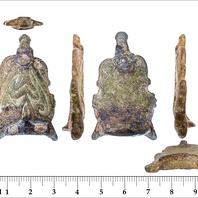
Viking Objects
Stirrup-Strap Mount (LIN-CFA7D4)
This example of an Anglo-Scandinavian cast copper-alloy stirrup-strap mount is classed as Williams Class A, Type 1A. It is decorated with a symmetrical pair of moulded beasts shown in profile in the Ringerike/Urnes style.
Read More
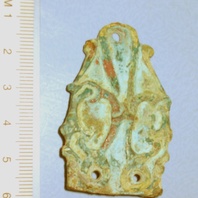
Viking Objects
Stirrup Strap Mount (NARC-C34373)
This cast copper-alloy stirrup strap mount is decorated with Ringerike style ornamentation and is classed under Williams Class A Type 1.
Read More
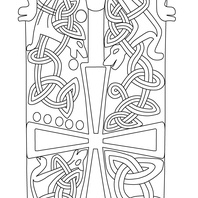
Viking Designs
Details from the Hickling Hogback
Detail drawings showing elements of the designs on the hogback stone, a type of Anglo-Scandinavian grave cover, from St Luke’s Church, Hickling, Nottinghamshire.
Read More
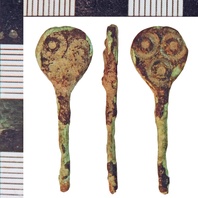
Viking Objects
Ring-and-Dot Pin (NLM-7A2D15)
Copper-alloy cast pin with a flat discoid head, no collar, and stamped decoration on the head, Flixborough type 601. The head bears three large [diameter 4.4mm] ring-and-dot motifs on each of its opposed faces. The tip of the shank is lost. The introduction of flat-headed pins with ring-and-dot decoration, superseding other types, is held by Dave Haldenby to mark the arrival of Viking settlers at Cottam, East Riding of Yorkshire. Suggested date: Early Medieval, 865-925. The finder suggests this to be part of an assemblage amounting to c.5% of material recovered from an extensive site, the rest being removed illicitly without record. Archaeological opinion holds the site to have been of equivalent character to Flixborough, North Lincolnshire, in terms of its material culture. Coins are under-represented in the group.
